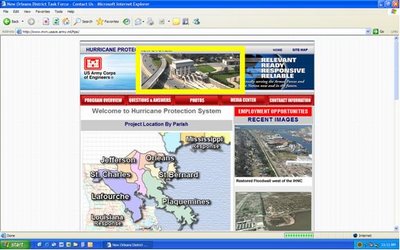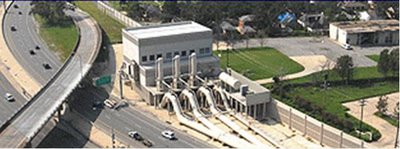Taking credit where it's not due
On the front page of the Corps' Hurricane Protection System webpage, there's a multi-image GIF that plays in the header. It shows various drainage structures around the area. I've highlighted the area in the picture below:

Here's the highlighted area blown up:

This image is of the I-10 pumping station near the Orleans/Jefferson parish line. It was built about two or three years ago by the Louisiana Department of Transportation and Development (LA DOTD) and was then turned over to the control of the New Orleans Sewerage & Water Board. It is an automated station that drains the nearby I-10 railroad underpass, which is notorious for flooding. Such flooding cuts off the main ingress and egress for New Orleans.
The Corps has absolutely nothing to do with this station. In fact, all interior pumping stations in New Orleans were specifically excluded as storm protection structures by the Federal government. This despite this conclusion from their own investigation into Katrina:
The way to recognize this "integral" role would be to place the drainage system on the Corps' Rehabilitation & Inspection Program (unfortunate acronym: RIP), which automatically provides federal dollars for repairs to structures on the list after a disaster. Here's a primer on the RIP. The actual Federal regulations governing the program are found here; the Corps' own Engineering Regulation ER 500-1-1 also talks about the program. Currently, none of the S&WB drainage system is on the RIP list, except for the levees along the outfall canals (yes, the levees that failed).
Because of the widespread devastation of Katrina, and the S&WB's inability to pay for repairs, the Corps - under special dispensation - is now solely responsible for many repairs to the S&WB drainage pumping stations. The repairs have lagged significantly. Since the Corps (or at least their webpage designers) want to somehow take credit for the I-10 station as if it's really a part of the federal hurricane protection system, let's look at what repairs are required at that station. According to the 11/1/06 Corps schedule of pump station repairs (which notes the station as "Non-fed"), the I-10 station is in line for the following contracts:
OPS-06A: Bearings
OPS-08: Electrical-Mechanical Repairs
OPS-09: Building and Structural Repairs (including the roof)
To my knowledge, the last two contracts have yet to be issued. The bearing contract just went out about two weeks ago. Today marks 477 days since Katrina.
Just for reference, here's the detailed damage estimate from the Orleans Parish Pump Station Project Information Report, or PIR, which lays out the scope of work for all the repairs (the PIR was approved on May 1, 2006 over three months after the rest of the post-Katrina repair work was approved):
DRAINAGE PUMPING STATION: I-10 UNDERPASS
Observations, Conclusions and Recommendations
Electrical:
1. Inspect all gear that was exposed to rainwater and covered by tarps due to roof leakage. Replace damaged components.
Mechanical:
1. Replace the bearings on Pumps P-1, P-2, P-3. These pumps were operated with “dirty water.” Pump P-4 was not run.
[editor's note: pumps P-1, P-2, and P-3 are the main 250 cfs pumps. P-4 is a 100 cfs constant duty pump]
2. Repair leaking expansion joint on 12 inch discharge line.
3. The control panel for the sump pumps requires replacement.
4. There was heavy damage to the waste oil system. Overhaul waste oil system.
Structural:
1. The floodwater reached a level of 7’-2” above the first floor. The operating level is on the second floor.
2. The roof leaks. It is apparent that the joint sealant between the pre-cast panels had blown out; therefore, all the joints should be resealed.
3. Ceiling tiles in the control room were missing or damaged; these should be replaced.
4. Replace (2) 3’ x 7’ metal doors, which were corroded and warped.
5. About 175 lf of 12’ vinyl fence, with a 15 ft gate, along the Academy Dr. side was destroyed; this should be replaced in kind.
6. A 6’ x 8’ noise reduction panel was missing. This should be replaced.
7. Reinstall one light pole at the suction basin, next to the crane mounted on the basin wall.

Here's the highlighted area blown up:

This image is of the I-10 pumping station near the Orleans/Jefferson parish line. It was built about two or three years ago by the Louisiana Department of Transportation and Development (LA DOTD) and was then turned over to the control of the New Orleans Sewerage & Water Board. It is an automated station that drains the nearby I-10 railroad underpass, which is notorious for flooding. Such flooding cuts off the main ingress and egress for New Orleans.
The Corps has absolutely nothing to do with this station. In fact, all interior pumping stations in New Orleans were specifically excluded as storm protection structures by the Federal government. This despite this conclusion from their own investigation into Katrina:
"The continued operation of pumping stations before, during and after a hurricane is essential to prevent, control and eliminate flooding. Pumping stations should be considered an integral part of the hurricane protection system; their design criteria should match that of levees and floodwalls."
The way to recognize this "integral" role would be to place the drainage system on the Corps' Rehabilitation & Inspection Program (unfortunate acronym: RIP), which automatically provides federal dollars for repairs to structures on the list after a disaster. Here's a primer on the RIP. The actual Federal regulations governing the program are found here; the Corps' own Engineering Regulation ER 500-1-1 also talks about the program. Currently, none of the S&WB drainage system is on the RIP list, except for the levees along the outfall canals (yes, the levees that failed).
Because of the widespread devastation of Katrina, and the S&WB's inability to pay for repairs, the Corps - under special dispensation - is now solely responsible for many repairs to the S&WB drainage pumping stations. The repairs have lagged significantly. Since the Corps (or at least their webpage designers) want to somehow take credit for the I-10 station as if it's really a part of the federal hurricane protection system, let's look at what repairs are required at that station. According to the 11/1/06 Corps schedule of pump station repairs (which notes the station as "Non-fed"), the I-10 station is in line for the following contracts:
OPS-06A: Bearings
OPS-08: Electrical-Mechanical Repairs
OPS-09: Building and Structural Repairs (including the roof)
To my knowledge, the last two contracts have yet to be issued. The bearing contract just went out about two weeks ago. Today marks 477 days since Katrina.
Just for reference, here's the detailed damage estimate from the Orleans Parish Pump Station Project Information Report, or PIR, which lays out the scope of work for all the repairs (the PIR was approved on May 1, 2006 over three months after the rest of the post-Katrina repair work was approved):
DRAINAGE PUMPING STATION: I-10 UNDERPASS
Observations, Conclusions and Recommendations
Electrical:
1. Inspect all gear that was exposed to rainwater and covered by tarps due to roof leakage. Replace damaged components.
Mechanical:
1. Replace the bearings on Pumps P-1, P-2, P-3. These pumps were operated with “dirty water.” Pump P-4 was not run.
[editor's note: pumps P-1, P-2, and P-3 are the main 250 cfs pumps. P-4 is a 100 cfs constant duty pump]
2. Repair leaking expansion joint on 12 inch discharge line.
3. The control panel for the sump pumps requires replacement.
4. There was heavy damage to the waste oil system. Overhaul waste oil system.
Structural:
1. The floodwater reached a level of 7’-2” above the first floor. The operating level is on the second floor.
2. The roof leaks. It is apparent that the joint sealant between the pre-cast panels had blown out; therefore, all the joints should be resealed.
3. Ceiling tiles in the control room were missing or damaged; these should be replaced.
4. Replace (2) 3’ x 7’ metal doors, which were corroded and warped.
5. About 175 lf of 12’ vinyl fence, with a 15 ft gate, along the Academy Dr. side was destroyed; this should be replaced in kind.
6. A 6’ x 8’ noise reduction panel was missing. This should be replaced.
7. Reinstall one light pole at the suction basin, next to the crane mounted on the basin wall.

0 Comments:
Post a Comment
<< Home